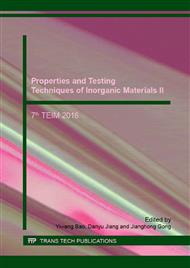p.95
p.100
p.105
p.110
p.115
p.120
p.127
p.132
p.137
Monitoring Early Hydration of Concrete with Ground Penetrating Radar
Abstract:
A nondestructive method is designed and employed to monitoring the early hydration of concrete mixes. The concrete mixes are prepared with Portland cement content and water to cement ratio 0.45. Retarder (citric acid) and accelerator (triethanolamine) are used to investigate the effects on the hydration process. The variations of dielectric constant and the intensity of reflected EM wave (amplitude) are measured within the frequency of 1.5GHz using Ground Penetrating Radar (GPR) at 25 °C for each sample from 10min to 3 days after mixing with water. The electric resistivity of Portland cement paste samples is measured using a non-contacting electric resistivity device at 25 °C.The amplitude tested changes sharply corresponding to the changes of microstructure and hydration products in the concrete mix during early hydration. The relative dielectric constant decreases with increasing hydrating time. The electrical resistivity changes in agreement with the dielectric properties. The dielectric properties mainly depend on the electrical properties and water content. The test results of samples in presence of retarder and accelerator shows that the relative dielectric constant decrease slower and faster respectively compared to the plain sample. The effect of these two admixtures can be reflected on the amplitude-time curve. The results demonstrate that the dielectric properties of concrete mix can be used as an effective ways of studying the hydration progress of concrete during hydration.
Info:
Periodical:
Pages:
115-119
Citation:
Online since:
January 2017
Authors:
Price:
Сopyright:
© 2017 Trans Tech Publications Ltd. All Rights Reserved
Share:
Citation:


